Manuscript accepted on :24-Aug-2018
Published online on: 07-09-2018
Plagiarism Check: Yes
Reviewed by: Kaviarasan
Second Review by: Revathi
Final Approval by: Alessandro Leite Cavalcanti
M. Amin Mir1, Shalini Upadhay1 and Bilal Ahmad Mir2
1Department of Chemistry Uttaranchal University, Premnagar, Dehradun.
2Uttaranchal (PG) College of Biomedical Sciences and Hospital Dehradun.
Corresponding Author E-mail: mohdaminmir@gmail.com
DOI : https://dx.doi.org/10.13005/bpj/1487
Abstract
The earth worm extracts have been analysed for the inhibition of alpha amylase and alpha glycosidase enzymes, which are the key enzymes for the control of glucose in the human system so have direct impact upon the health of an organism. These two enzymes have direct involvement in the diabetic process. So the inhibition of these two enzymes helps in the reduction of diabetes. Various extracts of the earth worms, viz, Ethyl acetate, Acetone, DMSO, Ethanol and Water have been analysed against the inhibition of the respective enzymes. Among the various extracts it had been found that water extract posses the highest inhibition potential followed by ethanol extract. The DMSO, Acetone posses the inhibition potential in between water extract and the Ethyl acetate extract. So it could be concluded that polar solvents posses high inhibition potential than the lesser polar solvents, which could be due the polar extracted compounds from the concerned extract of earth. Diabetes mellitus is spreading at an alarming rate in the world and three fourth of the world population is being getting effected by the disease in reference, which leads to major cause of high economic loss in the development of nations. The uncontrolled diabetes leads to many chronic complications like blindness, heart issues, and renal failure, etc. Therapies have been developed along with the principles of western medicine (allopathic) which often have limited efficacy, which carry the risk of adverse effects, and are often too costly, especially for the developing countries. But the research in reference is the first research in the world in which it had been shown that earth worm extracts can be used as anti-diabetic medicines. Other properties of earth worms, like antimicrobial anti-inflammatory etc are known already but the anti-diabetic effect has been analysed first time in the world.
Keywords
Alpha-Amylase; Alpha Glycosidase; Antidiabetic; Earth Worms; Plant Extracts
Download this article as:| Copy the following to cite this article: Mir M. A, Upadhay S, Mir B. A. Inhibition of Alpha Amylase and Alpha Glycosidase Enzymes by Various Earth Worm Extracts. Biomed Pharmacol J 2018;11(3). |
| Copy the following to cite this URL: Mir M. A, Upadhay S, Mir B. A. Inhibition of Alpha Amylase and Alpha Glycosidase Enzymes by Various Earth Worm Extracts. Biomed Pharmacol J 2018;11(3). Available from: http://biomedpharmajournal.org/?p=22361 |
Introduction
In Chinese language, the term earthworm (qiu yin) implies the movements of the worm, either forward or curving as a mound. According to the Compendium of Materia Medica (1552-1593) in the 16th century, earthworms are mostly found in swamps, pond areas, or in moist soil. They emerge out from the earth in the month of summer and hide in winter seasons. During rainy seasons, they will come out of the earth, and in the sunny, they “sing” at night. The earthworm which are used in medicine has a white segment or “neck”. Earthworms have been used as medicine for various remedies since 1340 AD.1 Earthworm extracts have been found to be as anti- inflammatory, analgesic and antipyretic agents.2 It earth worm extracts act as an anticancer agent by preventing excess glucose uptake3 and also the Earthworm surface excreta have potent antimicrobial activity.4 The earth worms have anticoagulatory or fibrinolytic activity which results in the facilitation of blood circulation.5 The earthworms have been known to posses’ proteases which dissolve the fibrin clots or anticoagulants and selectively interfere with the intrinsic pathway of blood coagulation cascade.6-10 Over all the extracts of earth worm extracts have potential medicinal properties.11-15
Experimental
The Pheretima Asiatica was collected from the local necessary of Dehradun.
Preparation of Earthworm Extracts
Approximately 500 cultured earthworms were collected and were washed in running water to remove extra dirt from the body surfaces. The dirt free earthworms were soaked in distilled water for 6 to 8 hours so that the soil in their tract could come out. Later the earthworms are washed thoroughly with distilled water and were collected in petri plates, which were then kept in an incubator for 24 hours at 55°C. After 24 hours earthworms are removed and crushed into powder. The powder was stored in a refrigerator at normal temperature and were used for extraction purpose. (Yegnanarayan et al.,1987).
Extraction
Separately plant root, stem and leaf powder were weighed and then extracted in a Soxhlet Apparatus using thimble in the extraction. Ethyl acetate, Acetone, DMSO, Ethanol and Water have been used as extraction solvents.
Extraction A
The sample was extracted first with (Ethylacetate) in a Soxhlet apparatus for a required period. After the Extraction with Petroleum ether, the extract solution was subjected to filtration, the residue was further extracted with another solvent. The filtrate was collected and evaporated to remove the volatile solvent to its 1/4th volume on water bath at a suitable temperature. The filtrate was then made in solid form (powdered) after being kept in an oven at 40-600C. The residue was collected, and subjected to further extraction process.
Extraction B
The residue was then extracted with acetone in a same manner as mentioned above, in extraction A. Similarly the residues were collected and extracted with DMSO and Ethanol as mentioned in the above extraction processes.
Extraction C
The residue from extract of ethanol was subjected to Water extraction by decoction technique in which the extract was dissolved in 500 ml of water. The whole mixture was heated on water to 1/5th of its original volume. Then further 500 ml of water was added to the extract, the whole mixture was further evaporated to remove nearly 300 ml of water. The obtained solution was subjected to filtration and then the filtrate was evaporated to 1/4th of its volume. Finally the extract was dried in an oven at a temperature range 30- 500C.
In-vitro inhibition of extracts by alpha amylase, alpha glycosidase enzymes
Inhibition of alpha amylase Enzyme
Alpha amylase an – enzyme that hydrolyses alpha-bonds of large polysaccharide, such as glycogen and starch into low molecular weight molecules such as glucose and maltose. Alpha amylase inhibitory activity was based on the starch iodine method that was originally developed by Laila A. Shekib, Samir M. El-Iraqui, Taisser M Abo-Bakr.16 In alpha amylase inhibition method 1ml of substrate- potato starch (1% w/v), different concentrations of (Acarbose std drug /Plant extracts), 1ml of alpha amylase enzyme (1% w/v) and 2ml of acetate buffer (0.1 M, 7.2 pH) was added. NOTE- Potato starch solution, alpha amylase solution and drug solution was prepared in acetate buffer. The above mixture was incubated for 1 hr. Then 0.1 ml Iodine-iodide indicator (635mg Iodine and 1gm potassium iodide in 250 ml distilled water) was added to the mixture. Absorbance was taken at 565 nm in UV-Visible spectroscopy. % inhibition was calculated and all the tests were performed in triplicate.
Inhibition of alpha-glucosidase Enzyme
The alpha-glucosidase Enzyme inhibitory activity was determined by incubating a solution of starch substrate (2% w/v maltose or sucrose) 1 ml with 0.2 M Tris buffer having pH 8.0 and various concentration of plant extract for 5 min at 37°C. The reaction was initiated by adding 1 ml of alpha-glucosidase enzyme (1U/ml) to it followed by incubation for 40 min at 35°C. Then the reaction was terminated by the addition of 2 ml of 6N HCl. Then the intensity of the colour was measured at 540nm. Krishnaveni, S., B. Theymoli, and Sadasivam, S.17
Calculation of 50% Inhibitory Concentration (IC50)
The plant extract concentration which is required to scavenge 50% of the radicals (IC50) was calculated by using the percentage scavenging activities at different concentrations of the extract. Percentage inhibition (%I) was calculated by
% I = (Ac-As)/Ac X 100
[Shai, L. J., P. Masoko, M. Eloff, J.N.18Where as Ac = absorbance of the control and As = absorbance of the sample.
Observation and Results
Antidiabetic Property of Pheretima Asiatica extracts by inhibition of Alpha-glycosidase)
The alpha-amylase inhibition of various Pheretima Asiatica extracts have been analyzed, and it was found that (water extract Pheretima Asiatica) possesses the highest inhibition potential followed by (ethanolic extract). The percentage inhibition by Pheretima Asiatica extracts was found to be concentration dependent, percentage inhibition increases with the increase in the concentration of the Pheretima Asiatica extracts. The IC50 value was determined from the straight line graph. The IC50value of all the plant extracts was found lesser than the reference compound (ACAROSE). The IC50value of various plant extracts follows the order (ethyl acetate, Acetone, DMSO, Ethanol and water) was found to be (38.1, 28.2, 32.3, 19.1, 15.1) respectively.
Observation and Results
Antidiabetic Property of Pheretima Asiatica extracts by inhibiting Alpha-glycosidase enzymes
The inhibition of alpha-amylase by various Pheretima Asiatica extracts have been analyzed, and it was found that (water extract of Pheretima Asiatica) possesses the highest inhibition potential followed by (ethanolic extract). The percentage inhibition by Pheretima Asiatica extracts was found to be concentration dependent, percentage inhibition increases with the increase in the concentration of the Pheretima Asiatica extracts. The IC50 value was determined from the straight line graph. The IC50value of all the earth extracts was found lesser than the reference compound (ACAROSE).
Table 1: Showing Inhibition of alpha glucosidase enzymes by Acarbose Standard.
| S. No. | Conc. (μg/ml) | Abs. of Acarbose | % Red | IC50 Value |
| 1. | 10 | 0.291 | 44.13 | 12 |
| 2. | 20 | 0.267 | 58.21 | |
| 3. | 30 | 0.242 | 71.11 | |
| 4. | 40 | 0.227 | 82.21 | |
| 5. | 50 | 0.204 | 88.51 | |
| 6 | 60 | 0.185 | 91.21 | |
| 7. | 70 | 0.163 | 95.23 | |
| 8. | 80 | 0.146 | 96.14 | |
| 9. | 90 | 0.123 | 97.71 | |
| 10. | 100 | 0.086 | 98.37 |
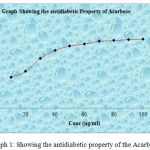 |
Graph 1: Showing the antidiabetic property of the Acarbose. |
Table 2: Inhibition of Alpha glycosidase enzymes by Ethyl acetate extract of the Pheretima Asiatica.
| S. No | Conc. (µg/ml) | Absorb. | % Red | IC50 |
| 1 | 10 | 0.075 | 27.88 | 56.1 |
| 2 | 20 | 0.073 | 29.80 | |
| 3 | 40 | 0.064 | 38.46 | |
| 4 | 60 | 0.049 | 52.88 | |
| 5 | 80 | 0.036 | 65.38 | |
| 6 | 100 | 0.034 | 67.30 |
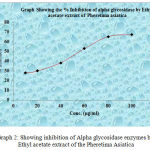 |
Graph 2: showing inhibition of Alpha glycosidase enzymes by Ethyl acetate extract of the Pheretima Asiatica. |
Table 3: Inhibition of Alpha glycosidase enzymes by acetone extract of the Pheretima Asiatica.
| S. No | Conc. (µg/ml) | Absorb. | % Red | IC50 |
| 1 | 10 | 0.797 | 11.93 | 35.7
|
| 2 | 20 | 0.654 | 27.73 | |
| 3 | 40 | 0.404 | 55.35 | |
| 4 | 60 | 0.277 | 69.39 | |
| 5 | 80 | 0.206 | 77.23 | |
| 6 | 100 | 0.179 | 88.64 |
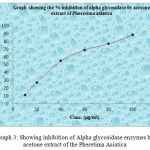 |
Graph 3: Showing inhibition of Alpha glycosidase enzymes by acetone extract of the Pheretima Asiatica. |
Table 4: Inhibition of Alpha glycosidase enzymes by DMSO extract of the Pheretima Asiatica.
| S. No | Conc. (µg/ml) | Absorb. | % Red | IC50 |
| 1 | 10 | 0.419 | 18.16 | 46 |
| 2 | 20 | 0.330 | 35.54 | |
| 3 | 40 | 0.282 | 44.92 | |
| 4 | 60 | 0.186 | 63.67 | |
| 5 | 80 | 0.126 | 75.39 | |
| 6 | 100 | 0.095 | 81.44 |
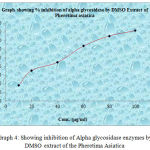 |
Graph 4: Showing inhibition of Alpha glycosidase enzymes by DMSO extract of the Pheretima Asiatica.
|
Table 5: Inhibition of Alpha glycosidase enzymes by Ethanol extract of the Pheretima Asiatica.
| S. No | Conc. (µg/ml) | Absorb. | % Red | IC50 |
| 1 | 10 | 0.312 | 35.35 | 30 |
| 2 | 20 | 0.254 | 45.54 | |
| 3 | 40 | 0.221 | 53.13 | |
| 4 | 60 | 0.153 | 62.10 | |
| 5 | 80 | 0.111 | 75.34 | |
| 6 | 100 | 0.075 | 82.41 |
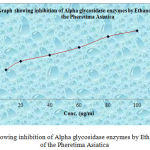 |
Graph 5: Showing inhibition of Alpha glycosidase enzymes by Ethanol extract of the Pheretima Asiatica. |
Table 6: Inhibition of Alpha glycosidase enzymes by water extract of the Pheretima Asiatica.
| S. No | Conc. (µg/ml) | Absorb. | % Red | IC50 |
| 1 | 10 | 0.299 | 40.35 | 22 |
| 2 | 20 | 0.242 | 49.14 | |
| 3 | 40 | 0.212 | 55.22 | |
| 4 | 60 | 0.132 | 67.21 | |
| 5 | 80 | 0.098 | 78.14 | |
| 6 | 100 | 0.065 | 85.21 |
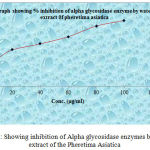 |
Graph 6: Showing inhibition of Alpha glycosidase enzymes by water extract of the Pheretima Asiatica. |
Inhibition of Alpha Amylase by various extracts of Pheretima Asiatica
The alpha-amylase inhibition by various Pheretima Asiatica extracts have been analyzed, and it was found that (water extract) posses the highest inhibition potential followed by (ethanolic extract). The percentage inhibition by earth worm extracts was found to be concentration dependent, percentage inhibition increases with the increase in the concentration of the extracts. The IC50 value was determined from the straight line graph. The IC50 value of all the earth worm extracts was found lesser than the reference compound (ACAROSE). The IC50 value of various earth worm extracts follows the order (water extract, ethanol extract, acetone extract, DMSO extract, Ethylacetate extract) and was found to be(15, 19, 28, 32, 38) respectively.
Table 7: Showing Inhibition of alpha amylase enzymes by Acarbose Standard.
| S. No. | Conc. (μg/ml) | Absorbance of Acarbose | % Red | IC50 Value |
| 1. | 10 | 0.291 | 44.13 | 13 |
| 2. | 20 | 0.267 | 57.21 | |
| 3. | 30 | 0.242 | 71.11 | |
| 4. | 40 | 0.227 | 82.21 | |
| 5. | 50 | 0.204 | 88.51 | |
| 6 | 60 | 0.185 | 91.21 | |
| 7. | 70 | 0.163 | 95.23 | |
| 8. | 80 | 0.146 | 96.14 | |
| 9. | 90 | 0.123 | 97.71 | |
| 10. | 100 | 0.086 | 98.37 |
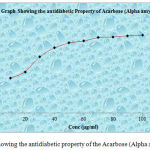 |
Graph 7: Showing the antidiabetic property of the Acarbose (Alpha amylase).
|
Table 8: Inhibition of Alpha amylase enzymes by Ethyl acetate extract of the Pheretima Asiatica.
| S. No | Conc. (µg/ml) | Absorb. | % Red | IC50 |
| 1 | 10 | 0.085 | 11.45 | 38 |
| 2 | 20 | 0.063 | 34.37 | |
| 3 | 30 | 0.061 | 36.45 | |
| 4 | 40 | 0.045 | 53.12 | |
| 5 | 50 | 0.025 | 73.95 |
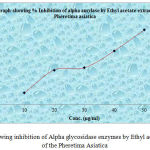 |
Graph 8: Showing inhibition of Alpha glycosidase enzymes by Ethyl acetate extract of the Pheretima Asiatica. |
Table 9: Inhibition of Alpha amylase enzymes by Acetone extract of the Pheretima Asiatica.
| S. No | Conc. (µg/ml) | Absorb. | % Red | IC50 |
| 1 | 10 | 0.017 | 19.04 | 28 |
| 2 | 20 | 0.013 | 38.09 | |
| 3 | 30 | 0.010 | 52.38 | |
| 4 | 40 | 0.008 | 61.90 | |
| 5 | 50 | 0.006 | 71.42 |
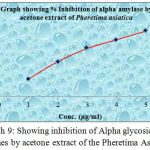 |
Graph 9: Showing inhibition of Alpha glycosidase enzymes by acetone extract of the Pheretima Asiatica. |
Table 10: Inhibition of Alpha amylase enzymes by DMSO extract of the Pheretima Asiatica.
| S. No | Conc. (µg/ml) | Absorb. | % Reduction | IC50 |
| 1 | 10 | 0.030 | 17.14 | 32 |
| 2 | 20 | 0.025 | 41.39 | |
| 3 | 30 | 0.017 | 49.58 | |
| 4 | 40 | 0.011 | 57.13 | |
| 5 | 50 | 0.009 | 79.12 |
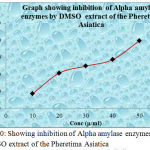 |
Graph 10: Showing inhibition of Alpha amylase enzymes by DMSO extract of the Pheretima Asiatica.
|
Table 11: Inhibition of Alpha amylase enzymes by ethanol extract of the Pheretima Asiatica.
| S. No | Conc. (µg/ml) | Absorb. | % Red | IC50 |
| 1 | 10 | 0.018 | 33.15 | 19 |
| 2 | 20 | 0.014 | 54.41 | |
| 3 | 30 | 0.010 | 74.16 | |
| 4 | 40 | 0.008 | 79.21 | |
| 5 | 50 | 0.007 | 82.14 |
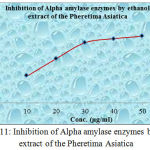 |
Graph 11: Inhibition of Alpha amylase enzymes by water extract of the Pheretima Asiatica. |
Table 12: Inhibition of Alpha amylase enzymes by water extract of the Pheretima Asiatica
| S. No | Conc. (µg/ml) | Absorb. | % Red | IC50 |
| 1 | 10 | 0.021 | 32.25 | 15 |
| 2 | 20 | 0.011 | 64.51 | |
| 3 | 30 | 0.009 | 70.96 | |
| 4 | 40 | 0.007 | 77.41 | |
| 5 | 50 | 0.006 | 80.64 |
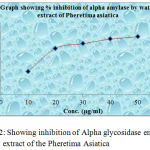 |
Graph 12: Showing inhibition of Alpha glycosidase enzymes by water extract of the Pheretima Asiatica. |
Discussion
Diabetes mellitus is spreading at an alarming rate in the world and three fourth of the world population is being getting effected by the disease in reference, which leads to major cause of high economic loss in the development of nations. The uncontrolled diabetes leads to many chronic complications like blindness, heart issues, and renal failure, etc. Therapies have been developed along with the principles of western medicine (allopathic) which often have limited efficacy, which carry the risk of adverse effects, and are often too costly, especially for the developing countries. But the research in reference is the first research in the world in which it had been shown that earth worm extracts can be used as anti-diabetic medicines. Other properties of earth worms, like antimicrobial anti-inflammatory etc are known already but the anti-diabetic effect has been analysed first time in the world.
The diseases which effect Liver at an alarming sequence appear to increase in our society. Chemical medicines are found to be cost effective in overcoming such types of diseases and but are also associated with side effects which are the biggest problems in the present life. An infinite number of plants and polyherbal medicines are claimed to have hepatoprotective activities. But in actual practice, only few plants stand pharmacologically evaluated for their efficacy. Pheretima Asiatica extracts have been evaluated for its antidiabetic properties by in-vitro inhibition of alpha amylase and alpha glucosidase enzymes.
The study is totally new and no any experiment had been performed so for by utilizing the Pheretima Asiatica extracts as antidiabetic medicines in nature. Previous studies have shown that the Pheretima Asiatica do bear antimicrobial effect. But the study in reference is totally new so further study should be carried out on the subject in reference.
Conclusion
Diabetes being considered as a metabolic disorder is major cause of high economic loss which in turn impedes the development of nations. Also the uncontrolled diabetes leads to many chronic complications such as blindness, general weakness, dizziness, heart failure, and renal failure. While considering these above mentioned diseases into consideration, the research development in hypoglycemic and potentially antidiabetic agents is the need of an hour. The study was carried out by using various extracts of the concerned animal. The exact mechanism responsible for the hypoglycemic effect is still unknown. Further studies should be carried out to identify the active constituents responsible for the hypoglycemic effect.
In conclusion it can be mentioned that Pheretima Asiatica extracts bear a good potential to overcome every problem in a human body. The concerned Pheretima Asiatica extracts possess a high degree of value as source of antidiabetic drug.
Every type of activity concerned with a particular organism is due to the presence of various biological signitures which remains in built within these organisms. The antidiabetic activity of the Pheretima Asiatica is due its potential in habit amylase productions, which in turn leads to non decomposition of higher carbohydrates there by make blood glucose leval within required limit of the cell.
References
- Stephenson J. The Oligochaeta, Oxford University Press. London. 1930.
- Noda N., Tsunefuka S., Tanaka R and Miyahara K. Effect of an earthworm, Lumbricus rubellus. Chem. Pharm. Bull. 1992;40:2756.
CrossRef - Nagasawa H., Sawaki K., Fuji Y., Kobayashi M., Segawa T., Suzuki R and Inatomi H. Biology of lysenin a protein in the coelomic fluid of earthworms. Anticancer Res. 1991;1061.
- Oleynik A. S and Byzov B. A. Response of bacteria to earthworm surface excreta. Microbiologiya. 2008;77:854-862.
CrossRef - Wang J. D., Narui T., Kurata H., Takouchi K., Hashimoto T and Okuyama T. Fibrinolytic activity of the earthworm extract. Chem. Pharm. Bull. 1989;37:2236.
CrossRef - Mann K.G., Neseirm M.E., Church W. R and Krishnaswamy S. Surface dependent reactions of the vitamin K- dependent enzyme complexes. Blood. 1990;76:1.
- Davie E.W., Fujikawa K and Kisiel W. The coagulation cascade: initiation, maintenance and regulation. Biochemistry. International Journal of Pharmaceutical Sciences and Research. 1991;30:103-163.
- Leipner C., Tuckova I., Rejnek J and Lagner J. Serine proteases in coelomic fluid of annelids Eisenia fetida and Lumbricus terrestris. Comp. Biochem. Physiol. 1993;105:679.
- Kim Y. S., Kim Y. E., Byun H. S and Chang C. S. Regulation of NAD+ glycohydrolase activity by ADP ribosylation. J. Biochem. Mol. Bio. 1995;28:398.
- Woo J., Bank Y. K., Yu K. H., Paik S. R and Chang C. S. Mechanism of Blood coagulation. J. Biochem Mol. Biol. 1996;29:500.
- Bristow H. S. Insects and other invertebrates for human consumption in Siam. Transactions of the Entomologicazl Society. 1932;80:387-404.
CrossRef - Ogata A and Mori H. J. Constituents of the earthworm as an antipyretic agent I. Journal of Pharmacological society of Japan. 1938;58:859-87.
CrossRef - Ogata A., Morimoto K and Mori H. J. Constituents of the earthworm as an antipyretic agent II. I brid. 1939;59:481-494.
- Carr L. G. K. Interesting animals, foods, medicines and omens of the eastern Indian with comparison to ancient Europe practice. Journal Washington Academy of Science. 1951;41:229-235.
- Yegnanarayan R., Sethi P. P., Rajhan P. A., Pulandiran K and Ismail S. A. Anti-inflammatory activity of total earthworm extracts in rats. Indian Journal of Pharmacology. 1987;19:221-224.
- Laila A. S., El-Iraqui S. M. , Abo-Bakr T .M. Studies on amylase inhibitors in some Egyptian legume seeds. Plant Foods Human Nutr. 1988;38:325–332.
CrossRef - Krishnaveni S. B., Sadasivam T. S. Phenol Sulphuric Acid method. Food Chem. 1984;15:229.
CrossRef - Shai L. J. P., Masoko M. P.,Mokgotho S. R., Magano M. A., Mogale N. B., Eloff J. N. Yeast alpha glucosidase inhibitory and antioxidant activities of six medicinal plants collected in Phalaborwa, South Africa. South African J. Bot. 2010;76:465-470.
CrossRef







